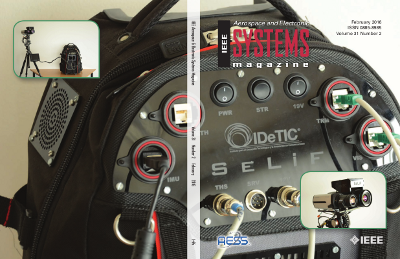Recientemente se ha publicado un artículo (February 2016 - ISSN 0885-8985 - Volume 31 Number 2) en la revista digital del IEEE (Aerospace and Electronic Systems Magazine) cuyos autores son miembros del IDeTIC: Javier Pérez Mato, Víctor Araña Pulido y Francisco Cabrera Almeida.
Javier Perez-Mato was awarded his M.Sc. in Telecommunications Engineering in 2010 by the University of Las Palmas de Gran Canaria (ULPGC). Prior to obtaining his M.Sc. he was granted a two-year scholarship (2007-2009) as an undergraduate research assistant at the Institute for Technological Development and Innovation in Communications (IDeTIC), where he now works as a full-time research engineer. For his M.Sc. thesis he designed a phase/amplitude calibration system for coupled-oscillator arrays, which are able to provide efficient beam-steering capabilities for radar and satellite communications.
Since February 2012 Javier holds a Master in Aerospace Science and Technology (MAST), given by the Polytechnic University of Catalonia (UPC). As part of his master thesis for the MAST he developed an optical wireless interface for the ARINC 429 avionics bus, which is the predominant data bus used on most commercial and transport aircraft.
Javier is currently taking a Ph.D. program in Telecommunication and Cybernetics at the ULPGC while he continues with his research activities.
Active research fields:
- Radio communications (satellite + terrestrial)
- Avionics
- Non-guided optical networks
- Communication subsystems for aerospace applications
- Unmanned Air Vehicles (UAVs)
Víctor A. Araña was born in Las Palmas de Gran Canaria, Spain, in 1965. He received the Telecommunication Engineering degree from the Universidad Politécnica de Madrid, Spain in 1990, and the Ph.D. degree from the Universidad de Las Palmas de Gran Canaria (ULPGC), Las Palmas, Spain, in 2004. He is currently an Assistant Professor with the Signal and Communication Department, ULPGC. He has been the leading researcher in several Spanish research and development projects and has taken part in a number of Spanish and European projects in collaboration with industries. His research interests include the nonlinear design of microwave circuits, control subsystem units and communications systems applied to data acquisition complex networks. Recently, drones applications and, forest fire detection and evolution have been included in that list.
Dr. Francisco Cabrera-Almeida was born in Las Palmas de Gran Canaria, Spain, in 1970. He received his Telecommunications Engineering degree in 1997 from the Universidad de Las Palmas de Gran Canaria (ULPGC), Spain, and his Ph.D. degree from ULPGC, in 2012. He is currently an Assistant Professor with the Signal and Communi- cations Department at ULPGC. He has taken part in a number of Spanish and European projects in col- laboration with industries and other universities. His research interests include: numerical electromagnetic modeling techniques, radiowave propagation and communications systems applied to data acquisition complex networks.
¿De qué trata el proyecto SeLIF?
Resumen en español:
Cada año miles de incendios forestales devastan grandes extensiones de bosque en todo el mundo. La detección y el seguimiento de estos incendios suele ser una tarea ardua y complicada, que se ve notablemente afectada cuando existen terrenos abruptos y condiciones meteorológicas adversas. Uno de los sistemas más empleados habitualmente en la detección de incendios forestales consiste en el uso de cámaras termográficas instaladas en puntos fijos de observación, que son puntualmente complementados por equipos aéreos o imágenes por satélite.
La detección de incendios forestales basada en puntos fijos de observación terrestres presenta una serie de inconvenientes, como pueden ser el campo de visión limitado, la falta de portabilidad y de reconfiguración o incluso la exposición permanente a las inclemencias meteorológicas y el vandalismo. Adicionalmente, una vez detectado el incendio, la georreferenciación del lugar afectado se realiza de forma manual por el personal de vigilancia, usando para ello las imágenes termográficas obtenidas. Esto añade un grado importante de subjetividad, lo cual puede afectar a la organización y efectividad del equipo de extinción.
Para solventar las limitaciones expuestas anteriormente, se propone el desarrollo de un sistema de detección de incendios forestales portátil y de despliegue rápido, que además cuente con un sistema novedoso de georreferenciación automática. Esto se consigue gracias un sistema desarrollado como parte del presente trabajo de investigación, que combina imágenes termográficas en tiempo real con el uso de tecnología de visión sintética.
Abstract in English:
Each year thousands of wildfires devastate large areas of forest worldwide. The detection and tracking of wildfires is usually a complicated task, specially affected by abrupt terrain characteristics and meteorological conditions. One of the most widely used systems for wildfire detection is that centered on thermographic cameras installed on strategic observation points, sometimes complemented by either airborne or satellite solutions.
Ground detection of wildfires based on fixed observation points presents some key disadvantages, such as limited field of view, non-portable form factor and permanent exposure to severe weather conditions and vandalism. In addition to the previous disadvantages, the georeferencing of the detected wildfire based on thermographic images is carried out manually by the staff supervising the acquired images, therefore adding an important degree of subjectivity.
To address the previous limitations, this paper proposes the development of a portable and rapidly deployable wildfire detection and tracking system with automated wildfire georeferencing capabilities. This is achieved by combining thermographic images with the use of synthetic vision technology.
Aerospace and Electronic Systems Magazine
Más información acerca del proyecto SeLIF.


